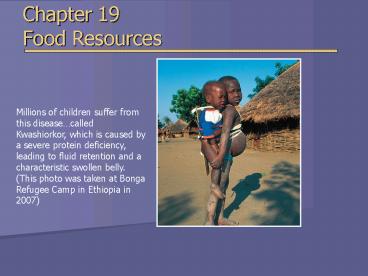Chapter 19 Food Resources - PowerPoint PPT Presentation
Title:
Chapter 19 Food Resources
Description:
Chapter 19 Food Resources Millions of children suffer from this disease called Kwashiorkor, which is caused by a severe protein deficiency, leading to fluid ... – PowerPoint PPT presentation
Number of Views:93
Avg rating:3.0/5.0
Title: Chapter 19 Food Resources
1
Chapter 19Food Resources
Millions of children suffer from this
diseasecalled Kwashiorkor, which is caused by a
severe protein deficiency, leading to fluid
retention and a characteristic swollen belly.
(This photo was taken at Bonga Refugee Camp in
Ethiopia in 2007)
2
Overview of Chapter 19
- World Food Security
- Food Production
- Challenges of Producing More Crops and Livestock
- Environmental Impact of Agriculture
- Solutions to Agricultural Problems
- Fisheries of the World
3
World Food Security
- Food Insecurity is Prevalent in Less-developed
nations! - According to the U.N. FAO (Food Agriculture
Organization), close to 1 billion people lack
access to the food needed for healthy, productive
lives! - 2 major diseases of undernutrition
- Marasmus the progressive emaciation caused by a
lack of protein and calories. Most common in the
1st year of life in developing nations - Kwashiorkor (displaced child in Ghana)
under-nutrition caused by protein deficiency in
poor areas of most of the world - Symptoms include swollen belly, stunted growth,
brittle hair, apathy, etc.
4
World Food Security
- Feeding growing population is difficult
- Annual grain production (left) has increased
since 1970 - Grain per person has not (right)
5
World Food Security
- Famine
- Temporary but severe shortage of food, typically
caused by crop failure, drought, flood, war, or
some other catastrophic event. - Developing nations of Africa, Asia and Latin
America are most at risk - More people die from starvation due to overall
lack of adequate nutrition than from a short-term
famine episode.
6
World Food Security
- Maintaining World Grain Stocks
- Amounts of rice, wheat, corn and other grains
remaining from previous harvest - Provides measure of food security
- Decreased each year since 1987
- UN feels carryover stock should not fall below 70
days
7
(No Transcript)
8
Decline in Grain Stockcauses
- Rising temps
- Falling water tables and droughts
- Ethanol production
- More grain is going towards feeding livestock
- Increased meat consumption in developing countries
9
World Food Security
- Economics and Politics
- Cost money to store, produce, transport and
distribute food, and the places most in need of
food are the places that are least able to
produce it (Asia, Africa, and Latin America) - Getting food to those who need it is political
- Democratic countries are more likely to get food
supplies to those who need it than totalitarian
regimes are!
10
Poverty and Food
- 1.3 billion people are so poor they cannot afford
proper nutrition - More common in
- Rural than urban areas
- Infants, children and the elderly
11
Food Production
12
Animals as food
- Constitute 40 of the calories consumed in
developed countries - Only comprise 5 of calories consumed in
developing countries
13
Principle Types of Agriculture
- Industrialized agriculture
- Modern agriculture methods that require large
capital input, and less land and labor - Subsistence Agriculture
- Traditional agricultural methods, which are
dependent on labor and large amounts of land - Shifting cultivation, Slash and burn agriculture,
Nomadic herding, Intercropping
14
Industrialized Agriculture!
15
Challenges of Producing More Crop and Livestock
- Domestication and Genetic Diversity
- Domestication of crops and livestock causes a
loss of genetic diversity - Farmer selects and propagates animals with
desirable agricultural characteristics
16
Challenges of Producing More Crop and Livestock
- Increasing Crop Yield
- Food production increased in developed countries
(wheat (left) - Pesticides
- Selective breeding
17
Case-In-Point Green Revolution
- High Yielding Rice Varieties
18
Challenges of Producing More Crop and Livestock
- Increasing Livestock Yields.mostly dependent
upon 2 inputs - Hormone supplements
- US and Canada
- Not used in Europe
- Antibiotics
- 40 of antibiotics produced in US are used in
livestock operations - Problems with increased bacteria resistance
19
Antibiotic Use and Resistance
20
Genetic Engineering
- Manipulation of genes by taking specific gene
from a cell of one species and placing it into
the cell of an unrelated species
21
Genetically Modified Organisms
- Add beneficial characteristics to crops
- Additional nutrition
- Resistance to pests
- Drought resistances (below)
- Herbicides
22
Genetically Modified Organisms
23
Safety in Genetic Engineering
- Determined to be safe for human consumption
- Concerns about GMO seed or pollen spreading in
wild - Backlash against GMOs
- GMOs are not currently labeled
- FDA finds it would be counterproductive and
expensive to label
24
Environmental Impacts of Agriculture
25
Solutions to Agricultural Problems- Sustainable
Agriculture
26
(No Transcript)
27
Sustainable Agriculture
- Examples
- Natural Predator-prey relationships instead of
pesticides - Crop selection
- Crop rotation and conservation tillage
- Supplying nitrogen with legumes
- Organic agriculture
- Integrated Pest Management (IPM)
- Limited use of pesticides with sustainable
agriculture practices
28
Fisheries of the World - Problems
- No nation lays claim to open ocean
- Resource susceptible to overuse and degradation
- Overharvesting
- Many species are at point of severe depletion
- 62 of worlds fish stock are in need of
management action
29
Fisheries of the World - Problems
- Overharvesting (continued)
- Sophisticated fishing equipment
- Bycatch killed off
- Magnuson Fisheries Conservation Act
30
World Seafood Harvest
31
Fisheries of the World - Problems
- Ocean Pollution - dumping ground
- Oil
- Heavy metals
- Deliberate litter dumping
- Stormwater runoff from cities and agricultural
areas - Aquaculture
- Growing of aquatic organisms for human
consumption - Great potential to supply food
32
Fisheries of the World - Problems
- Aquaculture (continued)
- Locations of fisheries may hurt natural habitats
- Produce waste that pollutes adjacent water































